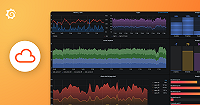Important: This documentation is about an older version. It's relevant only to the release noted, many of the features and functions have been updated or replaced. Please view the current version.
Configuring Pyroscope memberlist
Hash rings are a distributed consistent hashing scheme and are widely used by Pyroscope for sharding and replication. Pyroscope only supports hash ring via the memberlist protocol. You can configure memberlist by either the CLI flag or its respective YAML config option.
Memberlist
Pyroscope uses memberlist as the KV store backend.
At startup, a Pyroscope instance connects to other Pyroscope replicas to join the cluster.
A Pyroscope instance discovers the other replicas to join by resolving the addresses configured in -memberlist.join.
The -memberlist.join CLI flag must resolve to other replicas in the cluster and can be specified multiple times.
The -memberlist.join can be set to an address in the following formats:
<ip>:<port><hostname>:<port>- DNS service discovery
Note: At a minimum, configure one or more addresses that resolve to a consistent subset of replicas (for example, all the ingesters).
Note: If you’re running Pyroscope in Kubernetes, define a headless Kubernetes Service which resolves to the IP addresses of all Pyroscope pods, then set
-memberlist.jointodnssrv+<service name>.<namespace>.svc.cluster.local:<port>.
Pyroscope supports TLS for memberlist connections between its components. To see all supported configuration parameters, refer to memberlist.
Configuring the memberlist address and port
By default, Pyroscope memberlist protocol listens on address 0.0.0.0 and port 7946.
If you run multiple Pyroscope processes on the same node or the port 7946 is not available, you can change the bind and advertise port by setting the following parameters:
-memberlist.bind-addr: IP address to listen on the local machine.-memberlist.bind-port: Port to listen on the local machine.-memberlist.advertise-addr: IP address to advertise to other Pyroscope replicas. The other replicas will connect to this IP to talk to the instance.-memberlist.advertise-port: Port to advertise to other Pyroscope replicas. The other replicas will connect to this port to talk to the instance.
Fine tuning memberlist changes propagation latency
The pyroscope_ring_oldest_member_timestamp metric can be used to measure the propagation of hash ring changes.
This metric tracks the oldest heartbeat timestamp across all instances in the ring.
You can execute the following query to measure the age of the oldest heartbeat timestamp in the ring:
max(time() - pyroscope_ring_oldest_member_timestamp{state="ACTIVE"})The measured age shouldn’t be higher than the configured <prefix>.heartbeat-period plus a reasonable delta (for example, 15 seconds).
If you experience a higher changes propagation latency, you can adjust the following settings:
- Decrease
-memberlist.gossip-interval - Increase
-memberlist.gossip-nodes - Decrease
-memberlist.pullpush-interval - Increase
-memberlist.retransmit-factor
About Pyroscope DNS service discovery
Some clients in Pyroscope support service discovery via DNS to locate the addresses of backend servers to connect to. The following clients support service discovery via DNS:
- Memberlist KV store
-memberlist.join
Supported discovery modes
DNS service discovery supports different discovery modes. You select a discovery mode by adding one of the following supported prefixes to the address:
dns+
The domain name after the prefix is looked up as an A/AAAA query. For example:dns+memcached.local:11211.dnssrv+
The domain name after the prefix is looked up as a SRV query, and then each SRV record is resolved as an A/AAAA record. For example:dnssrv+_memcached._tcp.memcached.namespace.svc.cluster.local.dnssrvnoa+
The domain name after the prefix is looked up as a SRV query, with no A/AAAA lookup made after that. For example:dnssrvnoa+_memcached._tcp.memcached.namespace.svc.cluster.local.
If no prefix is provided, the provided IP or hostname is used without pre-resolving it.



